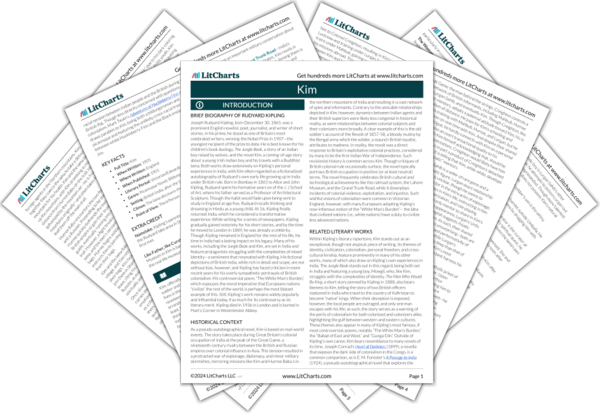Because Kim is an orphan, his mentors play a pivotal role in his upbringing. Although Kim provides for his own basic needs, like food and shelter, there are notable gaps in his development, and his mentors frequently assume responsibilities typically taken on by parents. This includes sending him to school, rewarding his accomplishments, teaching him essential life skills, and nurturing his emotional and spiritual development. Though Kim strictly maintains his independence from his mentors, at times threatening to sever ties should they cross certain boundaries, he frequently acknowledges the parental role they play in his life. On several occasions Kim describes the lama as his “mother and father,” a designation he extends to the old widow after healing him. Even Colonel Creighton, who maintains a greater distance from Kim, is considered by many to be “directly paternal,” and the same is true of Mahbub, Kim’s longtime friend, business partner, and confidant. In this way, Kim’s mentors come to resemble a kind of ad-hoc replacement family.
Though largely advantageous to Kim, this arrangement also has its challenges. None of Kim’s mentors share Kim’s complex identity and history, making it difficult for them to present, as a parent might, a singular roadmap for understanding and navigating his world. As a result, mentorship often leaves Kim feeling more lost and more confused than before, forced to try and reconcile an often-contradictory range of worldviews. As he tells a fellow Buddhist, “I too am a Seeker,” “though Allah alone knoweth what I seek.” In the end, however, this struggle proves beneficial for Kim, forcing him to wrestle with the enigma of identity rather than adopting a cookie-cutter one, like Father Victor’s insistence he become a “white man.” Though his mentors are unable to offer Kim a template for living his life, they provide him with the tools and support system to build his own—an approach that, the novel suggests, is more effective than simply telling a child who to be and how to live.
Mentorship and Parenthood ThemeTracker

Mentorship and Parenthood Quotes in Kim
Though he was burned black as any native; though he spoke the vernacular by preference, and his mother-tongue in a clipped uncertain singsong; though he consorted on terms of perfect equality with the small boys of the bazar; Kim was white – a poor white of the very poorest.
Kim followed like a shadow. What he had overheard excited him wildly. This man was entirely new to all his experience, and he meant to investigate further, precisely as he would have investigated a new building or a strange festival in Lahore city. The lama was his trove, and he purposed to take possession. Kim’s mother had been Irish too.
Kim warmed to the game, for it reminded him of experiences in the letter-carrying line, when, for the sake of a few pice, he pretended to know more than he knew. But now he was playing for larger things — the sheer excitement and the sense of power.
‘A blessing on thee.’ The lama inclined his solemn head. ‘I have known many men in my so long life, and disciples not a few. But to none among men, if so be thou art woman-born, has my heart gone out as it has to thee – thoughtful, wise, and courteous; but something of a small imp.
‘And I have never seen such a priest as thou.’ Kim considered the benevolent face wrinkly by wrinkle. ‘It is less than three days since we took the road together, and it is as though it were a hundred years.’
Oh, it is true. I knew it since my birth, but he could only find it out by rending the amulet from my neck and reading all the papers. He thinks that once a Sahib is always a Sahib, and between them they purpose to keep me in this Regiment or to send me to a madrissah [a school].
‘And I am a follower of the Way,‘ he said bitterly. ‘The sin is mine and the punishment is mine. I made believe to myself for now I see it was but make-belief – that thou wast sent to me to aid in the Search. So my heart went out to thee for thy charity and thy courtesy and the wisdom of thy littler years. But those who follow the Way must permit not the fire of any desire or attachment, that is all Illusion. As says…’ He quoted an old, old Chinese text, backed with another, and reinforced these with a third. ‘I stepped aside from the Way, my chela. It was no fault of thine. I delighted in the sight of life, the new people upon the roads, and in thy joy at seeing these things. I was pleased with thee who should have considered my Search and my Search alone. Now I am sorrowful because thou art taken away and my River is far from me. It is the Law which I have broken!’











